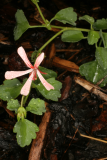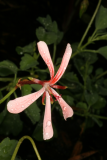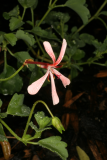Additional notes (click to expand)
Medicinal
All parts of the plant are astringent
Nomenclature
The genus Pelargonium derives its name from the resemblance of the shape of the fruit to the beak of a stork, pelargos in Greek. The species name acetosus (Latin), meaning sour, refers to the acid taste of the leaves. The common name sorrel-leaved pelargonium refers to the resemblance of the leaves to those of the herbal plant, sorrel or Rumex acetosa. P. acetosum was first cultivated in the Chelsea Physic Garden in England in 1724.
http://pza.sanbi.org/pelargonium-acetosum
Other use
The young leaves and buds can be eaten in salads and added to soups and stews, they have a pleasing, acidic, lemony taste.
http://pza.sanbi.org/pelargonium-acetosum
Geographical distribution
- Africa, Southern Africa, Cape Provinces
Pelargonium acetosum (L.) L'Hér.
Family: GERANIACEAEGenus: Pelargonium
Species: acetosum (L.) L'Hér.
Common names: Sorrel Crane's Bill
Distribution summary: Temperate S.Africa
Habit: Sub-Shrub
Hardiness: H1c - Heated greenhouse; warm temperate
Habitat: Dry, grassy slopes amongst rocks
Garden status: Currently grown
Garden location: Glasshouse (GLASSHOUSE)
Flowering months: May, June, July, August, September, October
Reason for growing: Medicinal, other use


